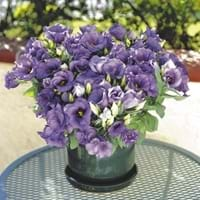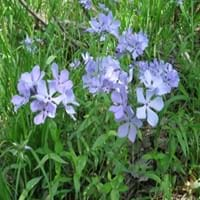Life Span
Biennial
Perennial
Type
Flowering Plants, Grass, Herbs
Flowering Plants
Origin
Southwestern United States, Mexico
Northeastern United States, Mid-Atlantic United States, Southeastern United States, Central United States, Texas, Canada
Types
'Balboa White' lisianthus, 'Forever Blue' lisianthus, 'Forever White' lisianthus, 'Lisa Pink' lisianthus
Blue Moon, Clouds of Perfume
Habitat
Grassland, Warmer regions
Rich Woods
USDA Hardiness Zone
8-11
4-8
Sunset Zone
1a, 1b, 2a, 2b, 3a, 3b, 4, 5, 6, 7, 8, 9, 10, 11, 12, 13, 14, 15, 16, 17, 18, 19, 20, 21, 22, 23, 24
1a, 1b, 2a, 2b, 3a, 3b, 4, 5, 6, 7, 8, 9, 10, 11, 12, 13, 14, 15, 16, 17
Habit
Upright/Erect
Mat-forming
Minimum Height
Not Available
Minimum Width
Not Available
Flower Color
White, Blue, Pink, Lavender, Blue Violet
Blue Violet
Flower Color Modifier
Bicolor
Bicolor
Fruit Color
Not Available
Not Available
Leaf Color in Spring
Gray Green
Green
Leaf Color in Summer
Gray Green
Green
Leaf Color in Fall
Gray Green
Green
Leaf Color in Winter
Gray Green
Not Available
Leaf Shape
Succulent
Ovate-lanceolate
Plant Season
Spring, Summer
Spring
Sunlight
Full Sun, Partial Sun
Partial Sun, Partial shade
Type of Soil
Clay, Loam, Sand
Loam
The pH of Soil
Neutral, Alkaline
Neutral
Soil Drainage
Well drained
Well drained
Bloom Time
Spring, Late Spring, Early Summer, Summer, Late Summer
Spring
Tolerances
Not Available
Not Available
Where to Plant?
Container, Ground, Pot
Container
How to Plant?
Seedlings, Stem Planting
Cuttings, Seedlings
Plant Maintenance
Medium
Medium
Watering Requirements
Form a Soil ring to water efficiently, It cannot sustain wet-feet, Keep the ground moist but not water-logged, Use Mulches to help prevent water loss during hot and windy weather, Water twice a day in the initial period
Requires regular watering
In Summer
Lots of watering
Lots of watering
In Spring
Moderate
Moderate
In Winter
Average Water
Average Water
Soil pH
Neutral, Alkaline
Neutral
Soil Type
Clay, Loam, Sand
Loam
Soil Drainage Capacity
Well drained
Well drained
Sun Exposure
Full Sun, Partial Sun
Partial Sun, Partial shade
Pruning
Cut or pinch the stems, Prune ocassionally, Remove dead or diseased plant parts, Remove deadheads
Remove dead flowers
Fertilizers
All-Purpose Liquid Fertilizer
Apply 10-10-10 amount
Pests and Diseases
Botrytis Blight, Cercospora leaf spot, Cucumber mosaic, Curvularia blotch, Downy mildew, Fusarium stem rot, Fusarium wilt, Impatiens necrotic spot, Lisianthus necrosis, Phyllosticta leaf spot, Pythium root rot, Rhizoctonia stem rot, Sclerophoma stem blight, Tobacco mosaic
Leaf spot, Powdery mildew, Rust
Plant Tolerance
Drought
Drought
Flower Petal Number
Single, Double, Semi-Double
Single
Foliage Texture
Medium
Medium
Foliage Sheen
Matte
Matte
Attracts
Bees, Butterflies
Hummingbirds, Butterflies
Allergy
Chest tightness, Diarrhea, Dizziness, Nausea, Vomiting
Mild Allergen
Aesthetic Uses
Beautification, Bouquets, Showy Purposes, Used for decorating walls, fences, gates, hedges, etc.
Ground Cover
Beauty Benefits
Not Available
Not Available
Environmental Uses
Air purification
Air purification
Medicinal Uses
Not Available
Boils, Eczema, Intestinal disorders
Part of Plant Used
Flowers
Flowers, Leaves, Root
Other Uses
Showy Purposes, Used for fragrance
As a tea substitute, Used as eyewash
Used As Indoor Plant
Yes
No
Used As Outdoor Plant
Yes
Yes
Garden Design
Bedding Plant, Container, Cutflower, Mixed Border, Wildflower
Mixed Border, Rock Garden / Wall, Wildflower
Botanical Name
EUSTOMA grandiflorum
PHLOX divaricata 'Blue Moon'
Common Name
Lisianthus, Florida blue,bBuebell
Wild Blue Phlox, Woodland Phlox
In Hindi
Lisianthus
Wild Blue Phlox
In German
Lisianthus
Wild Blue Phlox
In French
Lisianthus
Wild Blue Phlox
In Spanish
Lisianthus
Wild Blue Phlox
In Greek
Lisianthus
Άγρια μπλε Phlox
In Portuguese
Lisianthus
Wild Blue Phlox
In Polish
Eustoma
Dziki Niebieski Phlox
In Latin
Lisianthus
Phlox ferae blue
Phylum
Magnoliophyta
Magnoliophyta
Class
Magnoliopsida
Magnoliopsida
Order
Gentianales
Solanales
Family
Gentianaceae
Polemoniaceae
Clade
Angiosperms, Asterids, Eudicots
Angiosperms, Asterids, Eudicots
Tribe
Chironieae
Phlocideae
Subfamily
Not Available
Polemonioideae
Season and Care of Florida Blue and Wild Blue Phlox
Season and care of Florida Blue and Wild Blue Phlox is important to know. While considering everything about Florida Blue and Wild Blue Phlox Care, growing season is an essential factor. Florida Blue season is Spring and Summer and Wild Blue Phlox season is Spring and Summer. The type of soil for Florida Blue is Clay, Loam, Sand and for Wild Blue Phlox is Loam while the PH of soil for Florida Blue is Neutral, Alkaline and for Wild Blue Phlox is Neutral.
Florida Blue and Wild Blue Phlox Physical Information
Florida Blue and Wild Blue Phlox physical information is very important for comparison. Florida Blue height is Not Available and width Not Available whereas Wild Blue Phlox height is 30.50 cm and width 30.50 cm. The color specification of Florida Blue and Wild Blue Phlox are as follows:
Florida Blue flower color: White, Blue, Pink, Lavender and Blue Violet
Florida Blue leaf color: Gray Green
Wild Blue Phlox flower color: Blue Violet
- Wild Blue Phlox leaf color: Green
Care of Florida Blue and Wild Blue Phlox
Care of Florida Blue and Wild Blue Phlox include pruning, fertilizers, watering etc. Florida Blue pruning is done Cut or pinch the stems, Prune ocassionally, Remove dead or diseased plant parts and Remove deadheads and Wild Blue Phlox pruning is done Remove dead flowers. In summer Florida Blue needs Lots of watering and in winter, it needs Average Water. Whereas, in summer Wild Blue Phlox needs Lots of watering and in winter, it needs Average Water.





